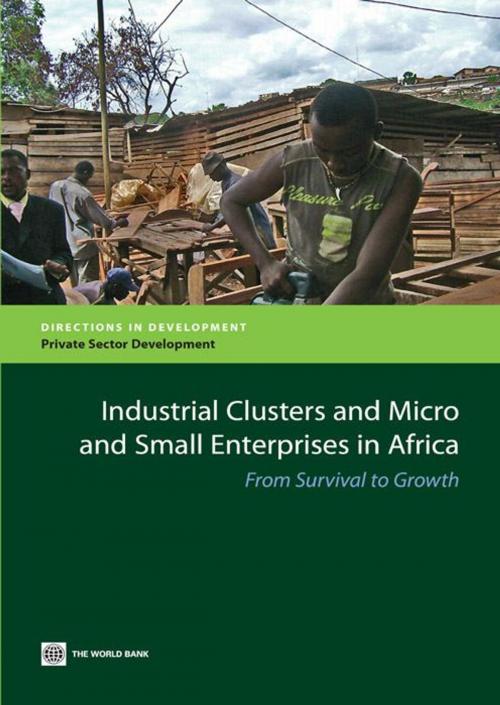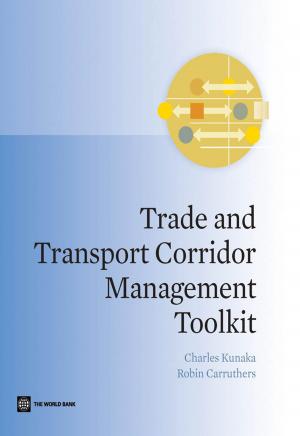Industrial Clusters and Micro and Small Enterprises in Africa: From Survival to Growth
Business & Finance, Economics, Development & Growth| Author: | World Bank | ISBN: | 9780821386286 |
| Publisher: | World Bank | Publication: | December 30, 2010 |
| Imprint: | Language: | English |
| Author: | World Bank |
| ISBN: | 9780821386286 |
| Publisher: | World Bank |
| Publication: | December 30, 2010 |
| Imprint: | |
| Language: | English |
The World Bank Japan International Cooperation Agency (JICA) Research Institute and the Foundation for Advanced Studies on International Development (FASID) in collaboration with researchers affiliated with the African Economic Research Consortium (AERC) recently conducted a study on Africa’s domestic enterprises to improve the understanding of the constraints micro and small enterprises in Africa face in improving productivity and expanding their markets. In Africa there are stark performance gaps between domestically owned enterprises and foreign-owned enterprises in terms of sales performance productivity and ability to reach distant markets. Among others size appears to be a dominant factor in explaining the gap. Against this background the study analyzes how naturally formed industrial clustersâ€concentrations of enterprises engaged in same or closely related industrial activities in specific locationsâ€could potentially mitigate constraints Africa’s micro and small enterprises face and enhance their business performance. The study is one of the first comprehensive quantitative inquiries on industrial clusters in Africa. The analysis specifically focuses on the role of spontaneously grown clusters of light manufacturing industries based on a set of original case studies of industrial clusters conducted for this research project. One of the key findings from the case studies was that cluster-based micro and small enterprises are performing better than similar micro and small enterprises outside of the clusters in terms of sales performance and ability to reach distant markets. Market access is a leading reason for cluster-based enterprises to choose their current locations. However cluster-based enterprises face another set of unique growth constraints. By the very nature of spontaneous agglomera¬tion new enterprises continue to flow to the clusters seeking the profit opportunities and better access to markets at such locations. The result can be intense competition in addition to increased congestion. Space constraints often impede growth within clusters. The lack of alternative locations available for industrial activities in the same cities generic infrastructure bottlenecks and unclear zoning policies and their unpredictable changes limit firms’ location choices and constrain their mobility. While competition should improve efficiency lack of capacity among those competing cluster-based enterprises to invest and innovate does not generate growth out of the competition. The vast majority of naturally formed clusters of light manufacturing industries in Africa are still at a “survival†level where agglomeration externalities are only limited to expand quantity but not quality as we observe in more advanced innovation-oriented clusters in elsewhere in the world. Existing studies on such natural industrial clusters in Africa have found that the lack of managerial skills among entrepreneurs running micro and small enterprises is a major constraint for innovation and growth in the clusters. As a part of this study pilot managerial skills training programs were conducted in two industrial clusters on an experimental basis where a group of randomly selected entrepreneurs within the clusters were given three-week long crush course of based management such as bookkeeping marketing business planning and production management. The impact evaluation of the experiments showed significant positive impacts of the training programs on value added and gross profits of enterprises. Raising the current survival-type industrial clusters which have been formed as a coping mechanism to weak investment climate into more dynamic innovating clusters will be an important avenue for fostering growth of micro and small enterprises in Africa. While national efforts to improve investment climate and investments in human capital are undoubtedly important there could be more targeted policies to be formulated in complementing general policies to support growth of micro and small domestic enterprises using existing industrial clusters as a natural springboard for their growth. In that context the study discusses the merit of cluster-based managerial human capital development to build steps toward more innovation-oriented clusters the importance of sound spatial planning policy particularly at the local level in the context of urban planning the need to expand market access and economic linkages for industrial clusters including regional integration and linkages with large enterprises.
The World Bank Japan International Cooperation Agency (JICA) Research Institute and the Foundation for Advanced Studies on International Development (FASID) in collaboration with researchers affiliated with the African Economic Research Consortium (AERC) recently conducted a study on Africa’s domestic enterprises to improve the understanding of the constraints micro and small enterprises in Africa face in improving productivity and expanding their markets. In Africa there are stark performance gaps between domestically owned enterprises and foreign-owned enterprises in terms of sales performance productivity and ability to reach distant markets. Among others size appears to be a dominant factor in explaining the gap. Against this background the study analyzes how naturally formed industrial clustersâ€concentrations of enterprises engaged in same or closely related industrial activities in specific locationsâ€could potentially mitigate constraints Africa’s micro and small enterprises face and enhance their business performance. The study is one of the first comprehensive quantitative inquiries on industrial clusters in Africa. The analysis specifically focuses on the role of spontaneously grown clusters of light manufacturing industries based on a set of original case studies of industrial clusters conducted for this research project. One of the key findings from the case studies was that cluster-based micro and small enterprises are performing better than similar micro and small enterprises outside of the clusters in terms of sales performance and ability to reach distant markets. Market access is a leading reason for cluster-based enterprises to choose their current locations. However cluster-based enterprises face another set of unique growth constraints. By the very nature of spontaneous agglomera¬tion new enterprises continue to flow to the clusters seeking the profit opportunities and better access to markets at such locations. The result can be intense competition in addition to increased congestion. Space constraints often impede growth within clusters. The lack of alternative locations available for industrial activities in the same cities generic infrastructure bottlenecks and unclear zoning policies and their unpredictable changes limit firms’ location choices and constrain their mobility. While competition should improve efficiency lack of capacity among those competing cluster-based enterprises to invest and innovate does not generate growth out of the competition. The vast majority of naturally formed clusters of light manufacturing industries in Africa are still at a “survival†level where agglomeration externalities are only limited to expand quantity but not quality as we observe in more advanced innovation-oriented clusters in elsewhere in the world. Existing studies on such natural industrial clusters in Africa have found that the lack of managerial skills among entrepreneurs running micro and small enterprises is a major constraint for innovation and growth in the clusters. As a part of this study pilot managerial skills training programs were conducted in two industrial clusters on an experimental basis where a group of randomly selected entrepreneurs within the clusters were given three-week long crush course of based management such as bookkeeping marketing business planning and production management. The impact evaluation of the experiments showed significant positive impacts of the training programs on value added and gross profits of enterprises. Raising the current survival-type industrial clusters which have been formed as a coping mechanism to weak investment climate into more dynamic innovating clusters will be an important avenue for fostering growth of micro and small enterprises in Africa. While national efforts to improve investment climate and investments in human capital are undoubtedly important there could be more targeted policies to be formulated in complementing general policies to support growth of micro and small domestic enterprises using existing industrial clusters as a natural springboard for their growth. In that context the study discusses the merit of cluster-based managerial human capital development to build steps toward more innovation-oriented clusters the importance of sound spatial planning policy particularly at the local level in the context of urban planning the need to expand market access and economic linkages for industrial clusters including regional integration and linkages with large enterprises.















